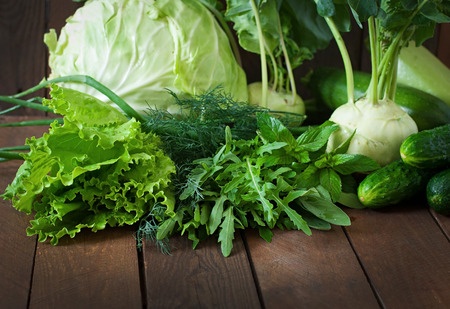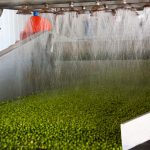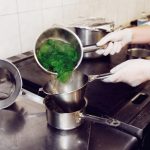
Re-greening is an important process for recovering the vibrant colouring of vegetables. This article looks at the use of zinc solutions in this process of recovering colour.
Heat processing of vegetables and fruits produces not only texture losses but a fading of the vibrant green colour which leaves the product looking pale and less appetising. The green colour is due primarily to the light processing pigments, chlorophylls a and b which are magnesium ion-porphyrin complexes. Heating partially degrades the pigments to yellow-olive coloured pheophytins and pyropheophytins (Buckle and Edwards, 1970; Schwartz and von Elbe, 1983). Colour loss is exacerbated by increases in acidity and an acidic pH (Haisman and Clarke, 1975).
Attempts to preserve the green colour by protecting the chlorophylls have included raising the pH to more alkaline values, altering and reducing key enzymatic changes (Clydesdale and Francis, 1968), and employing heat process treatments which minimise energy input. This includes high-temperature short-time treatments (HTST) (Tan and Francis, 1962; Malecki, 1978; Hekal and Erlandson, 1984; Schwartz and Lorenzo, 1991), high pressure processing and ohmic heating but none has been truly adopted on a commercial scale. More interestingly, metallo-chlorophyll complexes have potential use in the food industry to preserve the desirable fresh green colour of vegetables.
It was noted many years ago that re-greening of vegetables could be obtained by forming more stable metallo-chlorophyll complexes if the magnesium was replaced. If other metal cations like zinc and copper were added, the magnesium cation could be replaced at the centre of the porphyrin ring to produce a more stable, more heat resistant molecule and retain the colour. The transition metal chlorophyll derivatives form a firmer bond that is more resistant to acid and heat (Humphrey,1980). Well-known historic studies with processed okra and pea puree in glass jars and stored in the dark confirmed such metal complexation reactions.
The metallo-chlorophyll reaction has been characterized to a great extent. The formation of copper complexes occurs more readily than zinc complexes (Jones et al., 1977; von Elbe et al., 1986; Minguez- Mosquera et al., 1995). LaBorde and von Elbe (1994) proposed that colour stability was achieved when metal ions reacted only with chlorophyll derivatives and not with native chlorophyll itself. It has long been known that in a pure solution, a ratio of 1:1 between complexed metal and chlorophyll could be achieved. Complexation has been observed in pea puree stored at 37 °C (Schanderl et al., 1965a, b). The degradation products pheophytin a, pyropheophytin a, and pheophorbide a react with zinc to generate an improved green colour. However, the b forms of these chlorophyll derivatives have been reported to be less reactive (von Elbe et al., 1986; LaBorde and von Elbe, 1990). Tonucci and von Elbe (1992) reported that pheophytin a did not react to form the complex as rapidly as did pyropheophytin a. LaBorde and von Elbe (1994a and b) found that Zn-pyropheophytin a could be formed via two reactions, either from the further reaction of Zn-pheophytin a to form Zn-pyropheophytin or through zinc complexation with pyropheophytin a.
Studies have indicated that a colour stabilization process could be implemented in traditional retorting of chlorophyll-containing vegetables. Patents exist for the preservation of green colour in canned vegetables (Segner et al.,1984) and further investigations using alkaline conditions and HTST processing have been patented (Hekal and Erlandson, 1984, 1986). Leake and Kirk, (1992) devised a process that required the blanching of vegetables in an aqueous ZnCl2 solution followed by several thermal treatments.
Re-Greening using Zinc Chloride
Veri-Green™ was a patented process to improve the colour of canned green vegetables by adding zinc chloride to blanching solutions (von Elbe and Schwartz 1996). Von Elbe et al. (1986) realised blanching green beans for canning in a ZnCl2 solution produced the more stable green colour because of zinc complexes of pheophytin and pyropheophytin. Research then showed that the formation of the complexes depended on the Zn 2+ concentration, pigment concentration, and pH (LaBorde and von Elbe, 1990; 1994). A two-phase technology has then been developed to control the contact time between the product and the Zn solution. The vegetables are blanched in a Zn solution prior to the canning step that is performed without any added Zn. An example is processing peas in 50 – 500mg/L of ZnCl2 for 5 min at 83 °C, and then thermally processing without additional use of Zn in the canning solution (traditional method) (Canjura et al. 1999). Thermally processed fresh peas in Zn solutions has showed improved green colour in contrast to traditional processing (Canjura et al., 1999).
In spinch puree, a zinc chlorophyll complex only forms in purees when the metal content is 25 ppm or above, and generally full complexation occurs with 100 ppm zinc levels (von Elbe and Schwartz, 1996).
Subsequently, Zn-chlorophyll complexes have been created in leaves such as the pandan to generate a ‘natural’ extract. This produces a greener, more stable and natural colourant and with enzymatic extraction produces various Zn-chlrophyll derivatives. The leaves are treated with 300 ppm zinc chloride at pH 5 and 110°C for 15 mins. to produce the optimal conditions for complex formation (Senklang and Anprung, 2010).
Recent research has focused on the preservation of chlorophyll in aseptically processed green vegetables, which relies on less severe thermal treatments for sterilization (Schwartz and Lorenzo, 1991). Aseptic processing does not degrade as much chlorophyll as traditional canning, but eventually the increase in acidity during storage slowly degrades remaining chlorophyll.
In terms of protecting colour in fruits, zinc has been tried as a process aid in processed pears where the green peels are retained (Ngo and Zhao, 2005). The level of zinc that can be added is limited and copper cannot be used as a processing aid however. The US Food and Drug Administration (FDA) limits the Zn ion content to 75 mg/kg in the final product.
References
Buckle, K.A. and Edwards, R.A. (1970) Chlorophyll, colour and pH changes in HTST processed green pea puree. J. Food. Technol. 5 pp. 173-186.
Canjura, F.L., Watkins, R.H., Schwartz, S.J.( 1999) Color improvement and metallo-chlorophyll complexes in continuous flow aseptically processed peas. J. Food Sci 64(6) pp. 987–90.
Clydesdale, F.M. and Francis, F.J. (1968) Chlorophyll changes in thermally processed spinach as influenced by enzyme conversion and pH adjustment. Food Technol. 22: pp. 793-796.
Haisman, D.R., Clarke, M.W. (1975) The interfacial factor in the heat-induced conversion of chlorophyll to pheophytin in green leaves. J. Sci. Food Agri. 26(8) pp. 1111–26.
Hekal, I.M. and Erlandson, P.M. (1984) Process for improving the organoleptic properties of canned green vegetables. U.S. Patent 4,478,860.
LaBorde, L.F., Von Elbe, J.H. (1994a) Chlorophyll degradation and zinc complex formation with chlorophyll derivatives in heated green vegetables. J. Agric. Food Chem. 42 pp. 1100–3.
LaBorde, L.F., von Elbe, J.H. (1994b) Effect of solutes on zinc complex formation in heated green vegetables. J. Agric. Food Chem. 42 pp. 1096–9.
LaBorde, L.F., Von Elbe, J.H.,(1996) inventors; Friday Canning Corp., assignee. 1996 Jan 9. Method for improving the color of containerized green vegetables. U.S. Patent 5,482,727.
Minguez-Mosquera, M.I., Gallardo-Guerrero, L., Hornero-Mendez, D., Garrido-Fernandez, J. (1995) Involvement of copper and zinc ions in green staining of table olives of the variety Gordal. J. Food Prot. 58 pp. 564–569.
Ngo, T., Zhao, Y. (2005) Retaining green pigments on thermally processed peels-on green pears. J Food Sci . 70 C568–74.
Schwartz, S.J. and Lorenzo, T.V. (1991) Chlorophyll stability during continuous aseptic processing and storage. J. Food Sci. 54 pp. 1059-1062.
Schwartz, S.J. and von Elbe, J.H. (1983) Kinetics of chlorophyll degradation to pyropheophytin in vegetables. J. Food Sci. 48: pp. 1303-1306.
Segner, W.P., Ragusa, T.J., Nank, W.K., and Hoyle, W.C. (1984) Process for the preservation of green color in canned vegetables. U.S. Patent 4,473,591
Senklang, P., & Anprung, P. (2010). Optimizing enzymatic extraction of Zn–chlorophyll derivatives from pandan leaf using response surface methodology. J. Food Process. Preservation, 34(5), pp. 759-776.
Tan, C.T. and Francis, F.J. (1962) Effects of processing temperature on pigments and colour in spinach. J. Food Sci. 27: pp. 232-241.
von Elbe, J.H., Huan, A.S., Attoe, E.L., Kenneth Nank, W.( 1986) Pigment composition and color of conventional and veri-green canned beans. J. Agric. Food Chem. 34 pp. 52–4.
von Elbe, J.H., Schwartz, S.J. (1996) Colorants. In: Fenema OR, editor. Food chemistry. 2nd ed. New York: Marcel Dekker. pp 651–722.
Zheng, Y., Shi, J., Pan, Z., Cheng, Y., Zhang, Y., & Li, N. (2014). Effect of heat treatment, pH, sugar concentration, and metal ion addition on green color retention in homogenized puree of Thompson seedless grape. LWT-Food Science and Technology, 55(2), pp. 595-603.



I was intrigues by this article as I was looking for solutions to cooking vegetables that lose their colour with blanching and I noticed you have also written about that as well. I’m working for a chef in Newport. Really interesting stuff by the way and would like to chat to you about. I’ll send an e-mail to start further discussions.
You may not know this, but lots of people feed green beans to their dogs as treats or meal supplements. I started feeding my dogs green beans which had been treated with zinc chloride when I discovered them at a grocery store. I am beginning to wonder if this type of green bean may not be good for pets. I don’t feed them a lot at each meal–5 or 6 pieces of cut beans. Should I be concerned about doing this?
Hi Shelly, I don’t think you should be concerned about the zinc content in these beans. The recommended daily intake of zinc for a dog is somewhere between 2.5 and 4.5 mg per kg of dog body weight which is high. It also appears that there is no maximum level known for dogs. I don’t know the weight of your dog or how much zinc would be in your green beans but I would not be worried myself about it. Zinc, as in humans is an essential mineral especially in immunity as well as some other biochemical functions.
Should probably avoid food products with Zinc Chloride